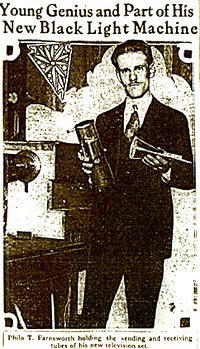 TeleVision
TeleVisionSARNOFF: He'd already told his father about the idea. He'd explained that "tele" was Greek. It meant "distant." Vision from a distance. Televsion.
The early isues of TV Guide magazine incorporated this idea into their magazine's logo.
Lee Wagner (1910–1993) was circulation director of McFadden Publications in New York in the 1930s—and later for Cowles Media Co.—distributing movie celebrity magazines. In 1948, he printed The TeleVision Guide for the New York area. On the cover was silent film star Gloria Swanson star of her short-lived "Gloria Swanson Hour." Wagner later added regional editions for New England and Baltimore-Washington areas. Five years later, he sold the editions to Walter Annenberg's Triangle Publications, but remained as a consultant until 1963.
The national TV Guide was first published on April 3, 1953. Its premiere issue cover featured a photograph of Lucille Ball's and Desi Arnez's son Desi Arnez Junior.
"Kukla, Fran and Ollie" (pictured above) is unique in the history of television: a live, daily, ad-libbed puppet show that was watched by more adults than children.How did a puppet show created for children become "appointment television" for millions of adults? And how was it possible to go on the air for a half-hour each day and create a sharp, witty program with no script?
The answer can be given in two words: Burr Tillstrom. Burr was the creator of "Kukla, Fran and Ollie," and the only puppeteer on the show, which first ran from 1947 to 1957. Today, it's hard to imagine a simple puppet show being so popular, but KFO evoked not only loyalty but also a deep belief in its characters from anyone who watched more than a few episodes. (from LIFE magazine)

























